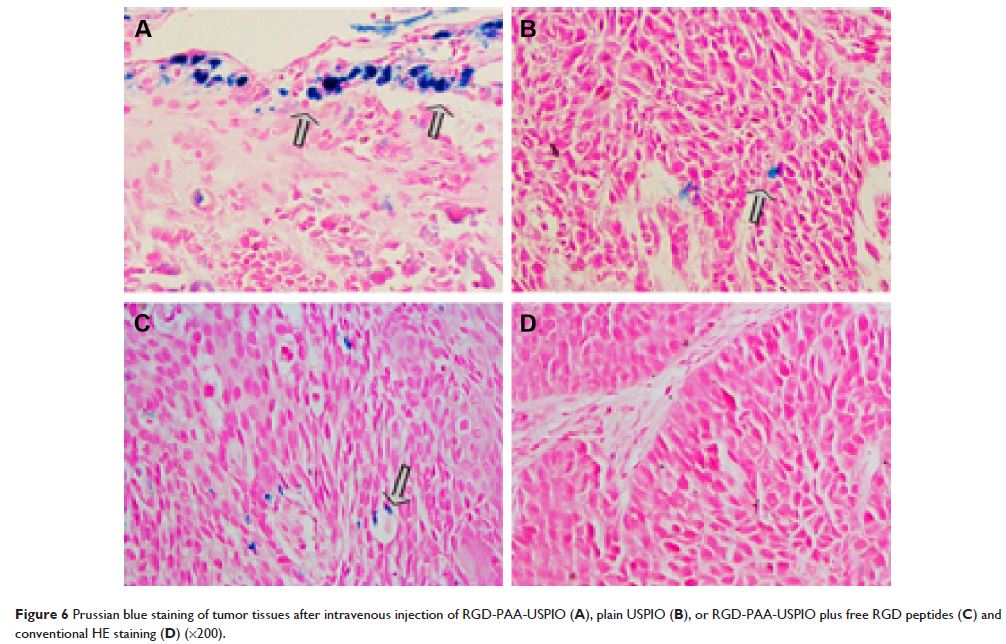3 2 2 5 3
论文已发表
注册即可获取德孚的最新动态
IF 收录期刊
- 7.056 Clin Epidemiol
- 3.851 Cancer Manag Res
- 3.779 Infect Drug Resist
- 2.581 Clin Interv Aging
- 2.822 Drug Design
- 3.157 Int J COPD
- 4.300 Int J Nanomedicine
- 2.198 Neuropsychiatr Dis
- 2.612 Onco Targets Ther
- 1.798 Patient Preference
- 2.200 Ther Clin Risk Manag
- 2.581 J Pain Research
MRI 与 RGD 共轭的超小超顺磁性氧化铁纳米颗粒用于对人类鼻咽癌异种移植模型早期抗血管生成治疗反应的无创检测
Authors Cui Y, Zhang C, Luo R, Liu H, Zhang Z, Xu T, Zhang Y, Wang D
Received 20 June 2016
Accepted for publication 19 September 2016
Published 14 November 2016 Volume 2016:11 Pages 5671—5682
DOI https://doi.org/10.2147/IJN.S115357
Checked for plagiarism Yes
Review by Single-blind
Peer reviewers approved by Dr Eytan Klausner
Peer reviewer comments 2
Editor who approved publication: Dr Linlin Sun
Purpose: Arginine-glycine-aspartic acid (RGD)-based nanoprobes allow specific
imaging of integrin αvβ3, a protein overexpressed during angiogenesis.
Therefore, this study applied a novel RGD-coupled, polyacrylic acid
(PAA)-coated ultrasmall superparamagnetic iron oxide (USPIO) (referred to as
RGD-PAA-USPIO) in order to detect tumor angiogenesis and assess the early
response to antiangiogenic treatment in human nasopharyngeal carcinoma (NPC)
xenograft model by magnetic resonance imaging (MRI).
Materials and methods: The binding specificity of RGD-PAA-USPIO with human
umbilical vein endothelial cells (HUVECs) was confirmed by Prussian blue
staining and transmission electron microscopy in vitro. The tumor targeting of
RGD-PAA-USPIO was evaluated in the NPC xenograft model. Later, mice bearing NPC
underwent MRI at baseline and after 4 and 14 days of consecutive treatment with
Endostar or phosphate-buffered saline (n=10 per group).
Results: The specific uptake of the RGD-PAA-USPIO nanoparticles
was mainly dependent on the interaction between RGD and integrin αvβ3 of
HUVECs. The tumor targeting of RGD-PAA-USPIO was observed in the NPC xenograft
model. Moreover, the T2 relaxation time of mice in the Endostar-treated group
decreased significantly compared with those in the control group both on days 4
and 14, consistent with the immunofluorescence results of CD31 and CD61 (P <0.05).
Conclusion: This study demonstrated that the magnetic resonance
molecular nanoprobes, RGD-PAA-USPIOs, allow noninvasive in vivo imaging of
tumor angiogenesis and assessment of the early response to antiangiogenic
treatment in NPC xenograft model, favoring its potential clinical translation.
Keywords: magnetic resonance imaging, ultrasmall
superparamagnetic iron oxide, integrin αvβ3, antiangiogenic therapy, Endostar,
nasopharyngeal carcinoma

